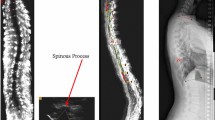Abstract
Purpose
The objectives of this preliminary study were to assess the reliability and accuracy of ultrasound (US) for measuring coronal curvature with and without the aid of a previous radiograph, and to evaluate the ability of US to detect curve progression in adolescent idiopathic scoliosis (AIS) patients.
Methods
Four raters measured 20 AIS US images twice at one-week intervals. Intra-rater reliability and correlation with radiograph were investigated with (rater 1) and without (raters 2–4) the aid of a previous radiograph. The center of lamina (COL) method was used to approximate the Cobb angle.
Results
Thirty-six curves were identified. All raters showed high intra-rater reliability (ICC[2,1] >0.80). With the aid of a previous radiograph, rater 1 showed higher correlation with radiograph (ICC[2,1] = 0.86), better standard error of measurement (SEM = 2.2°), and improved error index of selecting end-vertebrae (EI = 1.34), but no statistical improvement of intra-rater reliability (p > 0.05). For rater 2–4, the range of the ICC[2,1] values between US and radiograph measurements, the SEM value, and the range of the EI values were 0.70°–0.72°, 3.3°, and 1.65°–2.36°, respectively. Specificity and sensitivity of US for detecting curve progression were 0.91 and 0.83, respectively.
Conclusions
Using a previous radiograph as a measurement aid helped the user to measure coronal curvature from US images, and improved the accuracy of end-vertebrae selection. US showed high sensitivity and specificity for detecting curve progression, indicating that US may be a suitable, radiation-free alternative for monitoring patients with AIS who have mild or moderate curves.



Similar content being viewed by others
References
Sud A, Athanasios T (2013) Current concepts and controversies on adolescent idiopathic scoliosis: part I. Indian J Orthop 47(2):117–128
Cobb JR (1948) Outline for the Study of Scoliosis. Am Acad Orthop Surg Inst Course Lect 5:261–275
Tanure MC, Pinheiro AP, Oliveira AS (2010) Reliability assessment of Cobb angle measurements using manual and digital methods. Spine J 10(9):769–774
Zhang J, Lou E, Shi X, Wang Y, Raso JV, Le LH, Lv L (2010) A computer-aided Cobb angle measurement method and its reliability. J Spinal Disord Tech 23(6):383–387
Kuklo TR, Potter BK, Schroeder TM, O’Brien MF (2006) Comparison of manual and digital measurements in adolescent idiopathic scoliosis. Spine 31(11):1240–1246
Gstoettner M, Sekyra K, Walochnik N, Winter P, Wachter R, Bach CM (2007) Inter- and intraobserver reliability assessment of the Cobb angle: manual versus digital measurement tools. Eur Spine J 16(10):1587–1592
Srinivasalu S, Modi HN, Mehta S, Suh SW, Chen T, Murun T (2008) Cobb angle measurement of scoliosis using computer measurement of digitally acquired radiographs-intraobserver and interobserver variability. Asian Spine J 2(2):90–93
Mok JM, Berven SH, Diab M, Hackbarth M, Hu SS, Deviren V (2008) Comparison of observer variation in conventional and three digital radiographic methods used in the evaluation of patients with adolescent idiopathic scoliosis. Spine 33(6):681–686
Doody MM, Lonstein JE, Stovall M, Hacker DG, Luckyanov N, Land CE (2000) Breast cancer mortality after diagnostic radiography: findings from the U.S. Scoliosis Cohort Study. Spine 25(16):2052–2063
Ronckers CM, Doody MM, Lonstein JE, Stovall M, Land CE (2008) Multiple diagnostic X-rays for spine deformities and risk of breast cancer. Cancer Epidemiol Biomarkers Prev 17(3):605–613
Lee CF, Fong DY, Cheung KM, Cheng JC, Ng BK, Lam TP, Yip PS, Luk KD (2012) A new risk classification rule for curve progression in adolescent idiopathic scoliosis. Spine J 12(11):989–995
Weinstein SL, Zavala DC, Ponseti IV (1981) Idiopathic scoliosis: long-term follow-up and prognosis in untreated patients. J Bone Joint Surg Am 63(5):702–712
Tan KJ, Moe MM, Vaithinathan R, Wong HK (2009) Curve progression in idiopathic scoliosis: follow-up study to skeletal maturity. Spine 34(7):697–700
Lonstein JE, Carlson JM (1984) The prediction of curve progression in untreated idiopathic scoliosis during growth. J Bone Joint Surg Am 66(7):1061–1071
Sanders JO, Browne RH, McConnell SJ, Cooney TE, Finegold DN (2007) Maturity assessment and curve progression in girls with idiopathic scoliosis. J Bone Joint Surg Am 89(1):64–73
Wu H, Ronsky JL, Cheriet F, Harder J, Küpper JC, Zernicke RF (2011) Time series spinal radiographs as prognostic factors for scoliosis and progression of spinal deformities. Eur Spine J 20(1):1512–1519
Li M, Cheng J, Ying M, Zheng YP, Lam TP, Wong WY, Wong MS (2012) Could clinical ultrasound improve the fitting of spinal orthosis for the patients with AIS? Eur Spine J 21(10):1926–1935
Cheung CW, Law SY, Zheng YP (2013) Development of 3-D ultrasound system for assessment of adolescent idiopathic scoliosis (AIS): and system validation. Conf Proc IEEE Eng Med Biol Soc:6474–6477
Chen W, Lou EH, Zhang PQ, Le LH, Hill D (2013) Reliability of assessing the coronal curvature of children with scoliosis by using ultrasound images. J Child Orthop 7(6):521–529
Burwell RG, Aujla RK, Cole AA, Kirby AS, Pratt RK, Webb JK, Moulton A (2002) Preliminary study of a new real-time ultrasound method for measuring spinal and rib rotation in preoperative patients with adolescent idiopathic scoliosis. Stud Health Technol Inform 91:262–266
Driscoll CR, Aubin CE, Canet F, Labelle H, Dansereau J (2012) Impact of prone surgical positioning on the scoliotic spine. J Spinal Disord Tech 25(3):173–181
Currier DP (1984) Elements of research in physical therapy, 3rd edn. Williams & Wilkins, Baltimore, pp 160–171
Weir JP (2005) Quantifying test-retest reliability using the intraclass correlation coefficient and the SEM. J Strength Cond Res 19(1):231–240
Ungi T, King F, Kempston M, Keri Z, Lasso A, Mousavi P, Rudan J, Borschneck DP, Fichtinger G (2014) Spinal curvature measurement by tracked ultrasound snapshots. Ultrasound Med Biol 40(2):447–454
Acknowledgments
This study was supported through funding provided by Natural Sciences and Engineering Research Council of Canada and the Women and Children’s Health Research Institute.
Conflict of interest
The authors declare that they do not have any conflict of interest.
Author information
Authors and Affiliations
Corresponding author
Rights and permissions
About this article
Cite this article
Young, M., Hill, D.L., Zheng, R. et al. Reliability and accuracy of ultrasound measurements with and without the aid of previous radiographs in adolescent idiopathic scoliosis (AIS). Eur Spine J 24, 1427–1433 (2015). https://doi.org/10.1007/s00586-015-3855-8
Received:
Revised:
Accepted:
Published:
Issue Date:
DOI: https://doi.org/10.1007/s00586-015-3855-8



